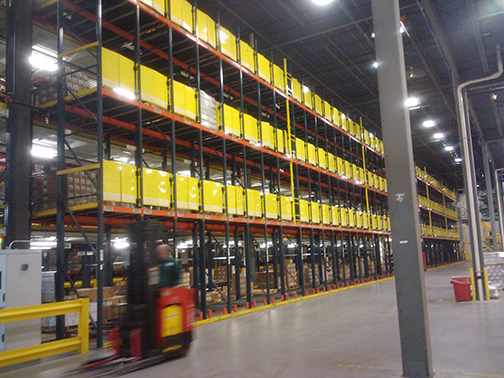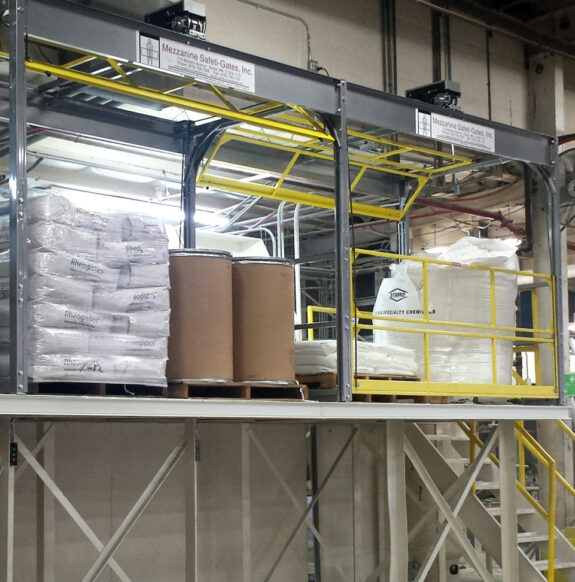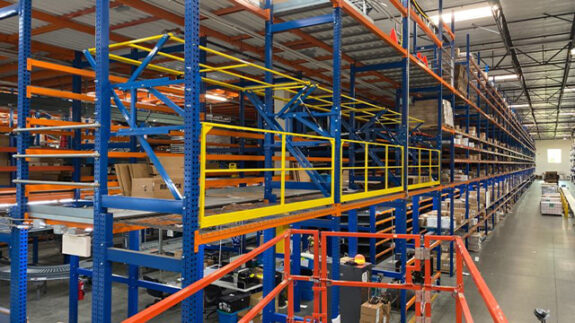
ProGMA - Protective Guarding Manufacturers Association
The Protective Guarding Manufacturers Association’s members are the industry’s leading suppliers of fixed protective guarding products designed to protect personnel, equipment, and inventory in industrial facilities. Member companies meet regularly to review, discuss, and revise the standards for design and performance of protective guarding products used in the material handling industry. ProGMA member companies are committed to the development, maintenance, and publishing of industry standard specifications for these systems.
Contact
8720 Red Oak Blvd. Ste 201
Charlotte
North Carolina
28217 USA
Ashley Skidmore
t: (+1) 704 676 1190
e: askidmore@mhi.org
w: www.mhi.org
Protective Guarding for Your Facility
This article helps facility managers to solve the puzzle of what protective guarding equipment is required at their warehouse or industrial facility.
If workers were encased in armor, like Iron Man, they always made perfect decisions, and they were never distracted, you might have a risk-free facility. Unfortunately, that seems like an impossibility. Facility operators, therefore, need to do their part to provide protective systems. That, along with intense safety training, goes a long way to limiting incidents where people are hurt, and property gets damaged.
The amount of safety guarding in a facility provides a snapshot of a company’s commitment to its workplace safety. These installs show a dedication to protecting their people, treating them as an asset to the business, as well as protecting property and infrastructure. Since protective guarding is a prominent display of safety culture, it helps employees know that safety is a big deal for their employer. Being able to say that makes a worker feel valued. That attitude, in turn, raises the overall prominence of safety in the facility.
If a facility doesn’t have protective guarding widely installed—from the loading dock to the stairways—its facility manager might recognize that he or she has a safety issue but might not be entirely sure what products would provide the needed protection. If that is the case, they’d be in the same position as many of their peers across North America. MHI’s Protective Guarding Manufacturers Association (ProGMA) is here to help.
There are safety solutions for loading docks, entrances, rack systems, conveyors, doorways, stairways, etc. Given the breadth of solution, it isn’t always clear where protective guarding (and budget) should be put first. And should an approach be taken based on expediency or by focusing on high-risk areas?
Importantly, it isn’t just a matter of installing guardrails and a facility will be safe; it must be a total concept change, which may include redesigning the layout of the facility, studying how employees walk around it, where powered industrial trucks (PITs) operate, where we can look to limit access, where access must be retained, and so on.
Once a study has been conducted as to where to make improvements then often, due to financial constraints, it is a matter of then identifying the areas of the facility that pose the highest risk to employee safety. Doing a little bit at a time is better than doing nothing at all. It also helps the decision-makers decide which products are best for locations and applications.
Safety management
What has evolved in recent years is that safety is now widely accepted as a key part of the facility manager’s job. Further, not only are many of them very familiar with protective guarding solutions, but they also understand the benefits of polymer and hybrid materials in addition to more traditional steel products. However, they may still have a blind spot to some areas of protective guarding, especially when it comes to the newer standards and specific uses. They also might not know which solution is best for which application.
Oftentimes the discussion about protective guarding equipment gets side-tracked by the age, size, type, and other variables about a facility. It is especially misleading to put old facilities in one box and newer ones in another. While it is true that an older or smaller facility may be less likely to have proper guarding in place, they are certainly not less likely to need it. Professionals at many small or older operations understand the value of employee safety just as much as newer, sprawling facilities.
In fact, older facilities often have a higher need for safety guardrails, as their buildings and production lines were not designed with safety and space for walkways in mind. In these instances, it can be challenging to find safety solutions that don’t inhibit operations but keep employees safe. In some older facilities, especially if they recently changed owners, management might pay more attention to safety guarding because they realize that the facility is outdated and needs to be upgraded.
Some of the new facilities, meanwhile, have consultants or system integrators involved that often specify proper guarding in the new design. But this doesn’t always happen, especially since larger facilities have a lot more areas to be concerned with, such as pick modules or pallet flow systems, where there is additional protective guarding needed. Here, pallet drop safety gates can provide fall protection or netting is used to keep material from falling from rack systems. In some newer facilities there is incorrect thinking that because the workplace is new it has all the guarding needed, but this might not be the case if it wasn’t designed into the system.
The extent to which ProGMA members service certain types of facility is thusly very varied. For many members it is about 50/50 in terms of new versus old. For others, it depends on the region, end-user markets involved, and other factors.
Retrofitting old, outdated, and / or damaged guardrail is a significant portion of some guarding manufactures’ work, especially as many facility managers and safety professionals are beginning to see the need for ‘fit for purpose’ products, and not just installing guardrail for guardrail’s sake. As ProGMA members remind customers, if it is not going to do the job intended, then it is pointless spending the time and money to install it. There is no point installing a low impact rated product in an area where heavy PITs operate, as it is not going to perform sufficiently should the need arise.
As an aside, ProGMA had identified a need for standardization that covers impact ratings and its first American National Standards Institute (ANSI) standard—Steel Mesh Containment Panels used in Pallet Rack Vertical Storage Systems Applications: Performance and Testing Requirements—was a step towards providing the marketplace with certified product testing protocol. ProGMA last year published another new standard for testing industrial guardrail barriers and posts. ANSI MH31.2-2021 provides a test method of evaluating performance characteristics for industrial guardrail barriers and barrier posts.
When a company performs a major retrofit, production change, or a new machinery installation, they create a perfect opportunity to bring in new safety guarding that meets the latest standards. If the guarding company is consulted on the project early enough, a plan can be devised to meet a wide variety of safety needs. This also creates a window to install safety guarding without additional production disruption and allows it to be designed in a way that integrates with the company’s operations seamlessly.
In one recent example, an end user pivoted to manufacture Covid test kits at the start of the pandemic and had to reconfigure its operations. That brought about the need for fall protection around some new pallet drop areas, and a ProGMA member helped them make sure their employees would be safe on the new production line.
Modern protective guarding
Technology and automation are changing the face of protective guarding—but only to an extent. It is true that there is less pedestrian traffic in facilities, and modern automated guided vehicles (AGVs) even communicate with safety gates to open or close devices, but pedestrians will always be present, and there will always be a need to make sure that pedestrian areas are clearly defined by introduction of designated walkways with guardrails. Humans are generally creatures of habit and if there is an apparent shortcut, they will take it to save time, hence guardrails provide that important physical barrier.
Due to the ongoing demand for increased automation in material handling, distribution, and manufacturing facilities, many ProGMA members now have options for power, remote operation, and tracking through their lines of pallet drop safety gates, for example. Innovators of pallet drop safety gates that provide fall protection for employees working on elevated areas, have created new configurations that work within the flow of a facility’s applications, offer no-touch environments, and fit with custom-engineered designs.
Other members also have systems that help facility managers see impacts on their warehouse racking in real time. They map out hotspots and help pinpoint high-risk areas. Once those areas are identified, protective guarding can be put into place to keep workers alert and minimize the risks created by impacts. Locations where PITs and pedestrians can come together should be prioritized. Any elevated ledges that are open where employees are working is a hotspot; the risk for falls which can lead to fatality, is great in those circumstances.
ProGMA itself offers a checklist that can help end users walk through their facility and determine what equipment they may need. Sometimes people might be overwhelmed with what must be secured and are not sure where to start. Technology is helping with this.
In conclusion, the amount of safety guarding in a facility is a barometer with which to measure a company’s commitment to workplace safety. Facility safety managers should always look for high quality equipment that can withstand repetitive use. End users want to make sure that the equipment is rugged yet ergonomic and doesn’t depend on employees to move or remember to use it. In other words, it should be built into the system wherever possible. Some lower priced / lower quality solutions may be acceptable in certain applications, but this is where it is important to consult an expert in the field to make sure a solution will work for that application.
ProGMA Protective Guarding Search Tool
Safety and facility managers across North America’s industrial sectors recently welcomed ProGMA’s Protective Guarding Search Tool, which aims to serve as a one-stop-shop for anyone looking for the guarding solutions to keep people and products safe. The Protective Guarding Search Tool addresses the myriad of protective guarding solutions that are available in the market and supports end users looking for the right products for their varying facilities. It is an environment where off-the-shelf products do not always work, and custom-engineered guarding is required in many scenarios.
Authors
- Paul Barlow, CEO, A-SAFE Inc.
- Aaron Conway, president, Mezzanine Safeti-Gates Inc.
- Ray Niemeyer, vice president, sales and marketing, SpaceGuard Products Inc.
- Haley Craig, marketing manager, SpaceGuard Products Inc.

Caption: The amount of safety guarding in a facility provides a snapshot of a company’s commitment to its workplace safety.

Caption: It is important to study how employees walk around a facility and where powered industrial trucks (PITs) operate.

Caption: There are safety solutions for loading docks, entrances, rack systems, conveyors, doorways, stairways, etc.

Caption: Facility safety managers should always look for high quality equipment that can withstand repetitive use.
About ProGMA
The Protective Guarding Manufacturers Association (ProGMA) members are the industry’s leading suppliers of fixed protective guarding products designed to protect personnel, equipment, and inventory in industrial facilities. Member companies meet regularly to review, discuss, and revise the standards for design and performance of protective guarding products used in the material handling industry. ProGMA member companies are committed to the development, maintenance, and publishing of industry standard specifications for these systems. Visit the website at mhi.org/progma.
About MHI
MHI is an international trade association that has represented the material handling, logistics and supply chain industry since 1945. MHI members include material handling and logistics equipment and systems manufacturers, integrators, consultants, publishers and third-party logistics providers. MHI offers education, networking and solution sourcing for their members, their customers and the industry as a whole through programming and events. The association sponsors the ProMat and MODEX expos to showcase the products and services of its member companies and to educate manufacturing and supply chain professionals.










